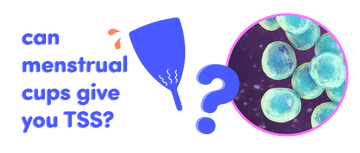Let’s chat: Can Menstrual Cups Cause TSS?
Feb 08, 2024

Let's Chat!!! Can you still get TSS from menstrual cups and discs?
In the realm of menstrual health, the rise of menstrual cups has been a game-changer for many, offering a reusable, eco-friendly alternative to traditional pads and tampons. But with new solutions come new questions, one of the most common being: Can menstrual cups cause Toxic Shock Syndrome (TSS)? It's time to clarify this concern with facts, clear up any confusion, and provide the information you need to make informed decisions about your menstrual health. Short answer is, if you use the cup correctly, you should be safe. Here’s some more info about TSS
Understanding TSS
Firstly, let's break down what TSS is. Toxic Shock Syndrome is a rare, but potentially life-threatening condition caused by toxins produced by certain types of bacteria, most commonly Staphylococcus aureus. TSS can affect anyone – not just menstruating individuals – but it became widely associated with menstruation in the 1980s due to cases linked to the use of super-absorbent tampons.
The Menstrual Cup Connection
Now, onto the main question: Can using menstrual cups increase the risk of TSS? The short answer is that the risk of TSS from menstrual cups is extremely low, it is not nonexistent. The only cases of TSS by menstrual cup are from users who don’t use the cup correctly.
Why the Risk Is So Low
Menstrual cups are designed to collect, rather than absorb menstrual blood. This key difference minimizes the risk of creating an environment that could favor bacterial growth. Additionally, because our menstrual cups are made from the highest medical-grade silicone, This design helps maintain a healthy vaginal environment and reduces the likelihood of bacterial growth and TSS.
Best Practices for Safe Use
To minimize the risk of TSS while using menstrual cups, it's crucial to follow best practices for hygiene and usage:
- Wash Your Hands: Always wash your hands thoroughly before inserting or removing your menstrual cup
- Keep It Clean: Regularly clean your menstrual cup according to the manufacturer’s instructions, typically by washing with our foaming cleanser or try one of our steamer bags for quick sanitizing. (You can also boil your cup if you don't have access to a steamer bag. Putting your cup in a whisk can help it from bopping at the top of the water.)
- Timely Change: Menstrual cups can be worn up to 12 hours, but you don’t have to wait a full 12 hours. If you’d like to be extra cautious, emptying every 6-8 would further lower the risk.
Listening to Your Body
It's good to be aware of the signs of TSS, which can include sudden fever, low blood pressure, vomiting, diarrhea, a rash resembling a sunburn, confusion, muscle aches, and headache. If you experience any of these symptoms, remove your menstrual cup immediately and seek medical attention.
The Bottom Line
The move towards menstrual cups is part of a broader shift towards more sustainable and body-friendly menstrual products. While the risk of TSS associated with menstrual cups is very low, especially when compared to other menstrual products, it's important to stay informed and practice good menstrual hygiene. By doing so, you can enjoy the benefits of menstrual cups while minimizing any risks, keeping your menstrual health both safe and sustainable.
Our favs:
Our favorite products for keeping clean?
Poppins Period Just Care Kit includes a foaming cleanser, a steamer bag, and a drying place to keep your cup clean. Every Poppins Period cup also comes with a breathable storage bag.

Check out more articles from The Periodical here.

